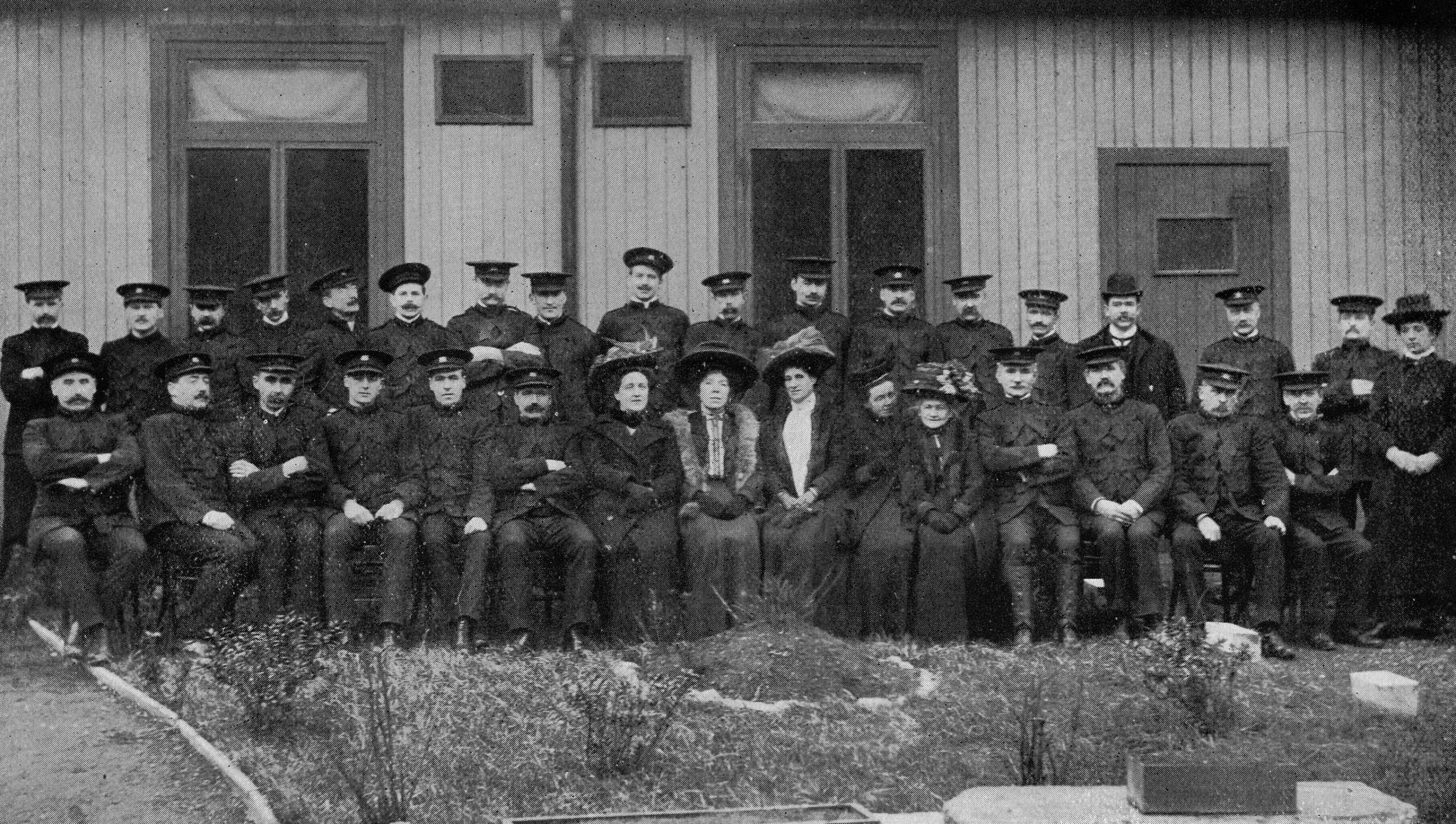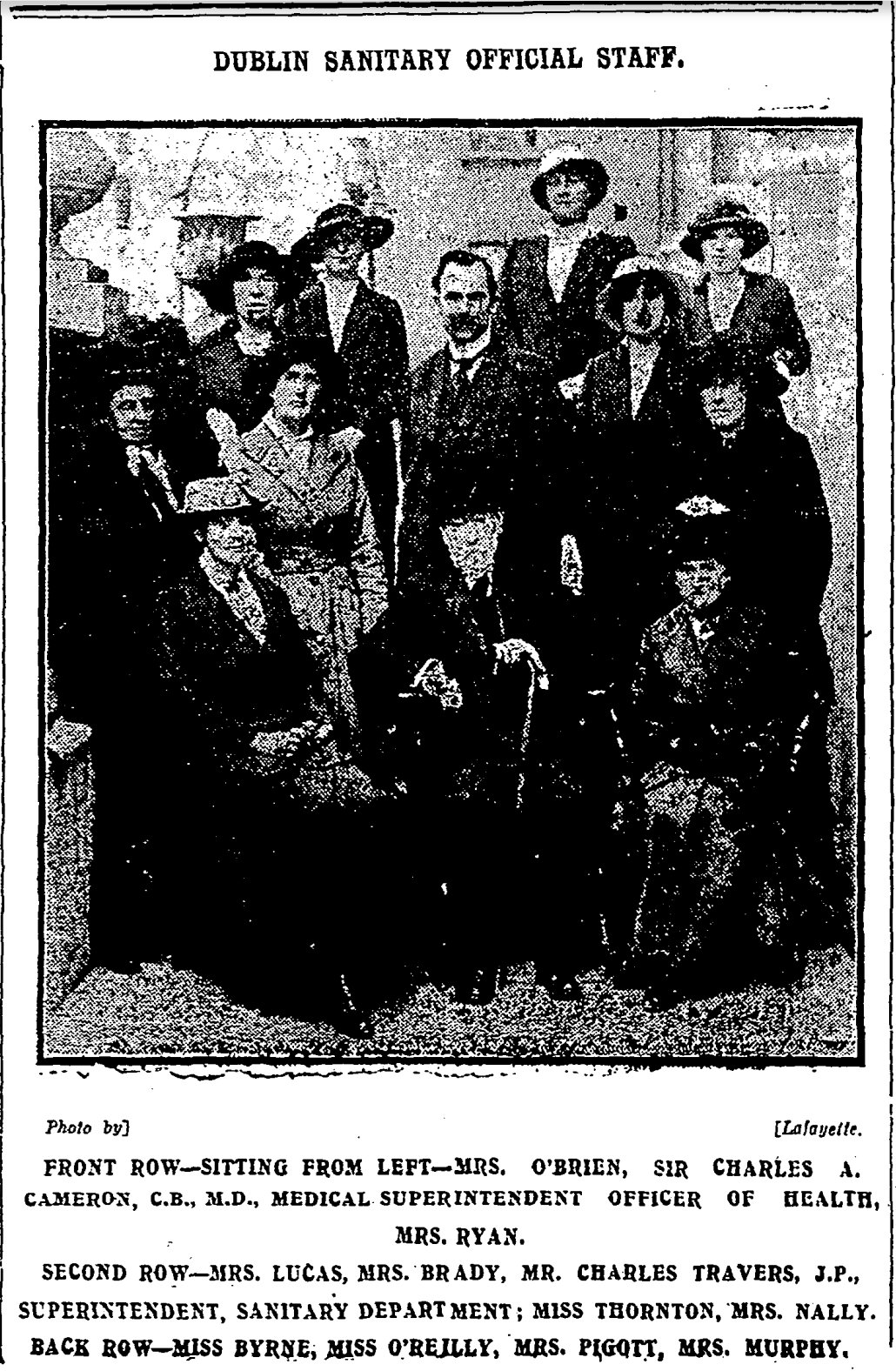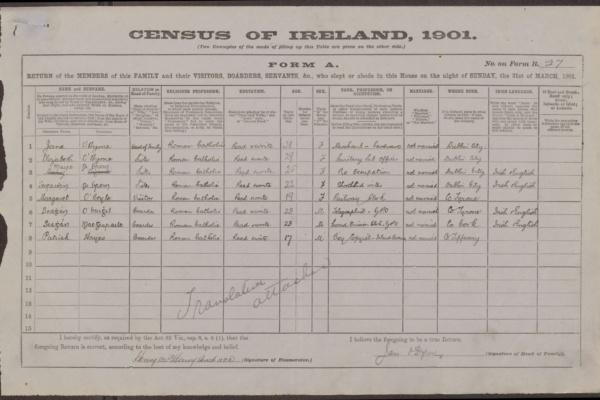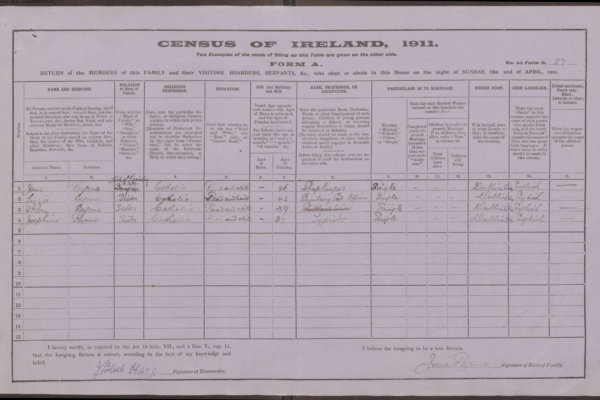

A biography of Elizabeth Byrne
One of our first records of Lizzie Byrne comes from the census. An Elizabeth O’Byrne and a Lizzie Byrne appear in the 1901 and 1911 censuses, living at 27 Manor Street, in the Arran Quay Ward of Dublin City. In both returns, Lizzie was living with her three sisters (one older, two younger). The Byrne sisters were all unmarried, and they were Catholic. Lizzie’s occupation in both 1901 and 1911 was given as ‘sanitary sub-officer.’ As she was the only sanitary inspector of that name (including its variations) working in Dublin and indeed Ireland at the time, we can be certain that our identification of her with the Elizabeth Byrne named in the Public Health Department records is correct.
The census records for the house in which Lizzie and her three sisters lived, at 27 Manor Street, Arran Quay, Dublin, in 1901 and 1911 (National Archives, CEN/1901/48/40/Manor Street and CEN/1911/49/57/Arran Quay; Reproduced by kind permission of the Director of the National Archives).
It is possible to piece together a history of Lizzie’s life – and a broader history of the Byrne family – from civil, church, and newspaper records, and to hypothesise as to why she became a sanitary inspector. There are, of course, many gaps.
Elizabeth Mary Byrne was born in November 1866. Her parents were Peter Byrne, who was the long-standing Assistant Master of the North Dublin Union Workhouse, and Jane Byrne (also née Byrne). Whether she had any other siblings in addition to her three sisters is unknown. Peter Byrne lost his wife, and the Byrne sisters their mother, in 1881, to bronchitis. Jane Byrne was 49 when she died. Peter Byrne appears to have retired from the North Dublin Union in or around 1888 on a substantial pension; but his death in 1895 seems to have caused a significant change in the family’s financial circumstances. According to a report in the Freeman’s Journal, a fund was started by friends and acquaintances ‘for the benefit of the four daughters of the deceased’. It is therefore possible that Lizzie and two of her sisters entered the workforce to support themselves – by 1901, Jane was a merchant and Josephine a typist. The Byrne sisters also had three male boarders living with them in 1901, which also supports this theory.
Lizzie is first recorded as sitting the Certificate in Sanitary Science, a qualification offered by the Royal Institute of Public Health, in July 1899. The certificate was a mandatory qualification for any new candidates appointed to the role of Sanitary Sub-Officer with Dublin Corporation from 1895 onwards. The first woman to sit the exam in Dublin and be appointed was Ellen Smith in 1898. When Lizzie sat the exam, the Public Health Department had advertised a vacancy for a second (temporary) woman sanitary inspector. She scored 47%, but the pass rate was 50%. She resat the exam in the September of the same year and achieved 62%. She was subsequently appointed to the role. After Lizzie’s appointment was made public, a London newspaper alleged that she only got her role through nepotism – and at the expense of a higher-scoring, more qualified candidate – though their identification of her as the daughter of a ‘late Corporation official’ was mistaken.

J.H. Glover, The Sanitary Sub-Officers of Dublin Corporation, 1909 (Image courtesy of Dublin City Library & Archive).
There were six female sanitary sub-officers by 1909. We think Lizzie is seated in the centre of the five women (the sixth woman inspector is standing far right) – though we aren’t entirely certain about that identification.
Lizzie was made a permanent member of the sanitary staff in 1901 along with Ellen Smith, Mary Lucas and Margaret Ryan (the latter two were appointed in January 1900), though they weren’t accorded equal pay with their male colleagues until 1913. Lizzie remained a sanitary sub-officer until at least 1920; she was overlooked for promotion to the position of Shop Inspector in 1912.
Along with her female colleagues, Lizzie provided written reports on her work under the Notification of Births Act, which Dublin Corporation adopted towards the end of 1910 and which was designed to reduce high levels of infant mortality. These were transcribed – seemingly unedited – in Charles Cameron’s departmental annual reports between 1910 and 1916 (see below for a transcription of one of Lizzie’s own reports).
Lizzie’s retirement date and the date of her death are unknown.

Lafayette, Dublin Official Sanitary Staff, 1915 (Image courtesy of Lafayette).
This photograph was printed as part of a feature in the Weekly Irish Times, 23rd October 1915, called ‘Women’s Work in Ireland’ (hence the grainy quality). Dublin’s women sanitary inspectors were praised in the feature as a “most important and useful body of women workers”. Lizzie is standing in the back row at the far left. Head of the Public Health Department Charles Cameron is seated in the centre.
A report by Lizzie Byrne
In 1914 I visited 855 cases [of new births].
The conditions in the homes of the poor struggling on small weekly pittances where births were notified and visited by me during the past twelve months was somewhat improved regarding cleanliness, but the difficulty still exists in convincing them of the necessity of opening their windows to admit the fresh air. The beds and bedding were the hardest to deal with as in most cases supplies of bed coverings was limited to that which was in actual use; this, therefore, entailed the necessity of doing without any while same was being washed. The cost of living at present is so high, the consideration of giving coal at 1s. per bag to the very poor is looked forward to as a great boon. The bonuses granted by the Government, too, to the relatives of those engaged in the war help considerably where the money is not ill-spent.
Of the above number, 12 infants were born delicate, 21 died shortly after birth, and 33 were stillborn.
Source: Report of Miss Elizabeth M. Byrne [regarding the Notification of Births Act, 1907], from Charles Cameron, Report upon the state of public health and the sanitary work performed in Dublin in the year 1914.




